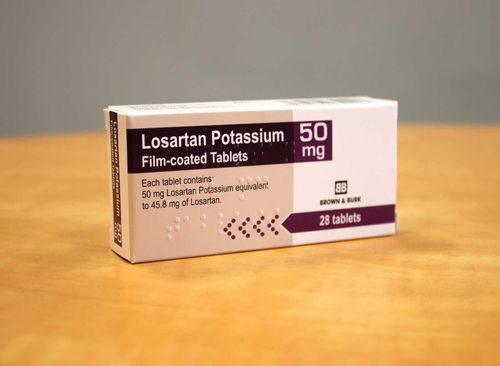This is an automatically translated article.
Botulinum toxin type A is an inhibitor of neuromuscular transmission, prepared as a powder for solution for injection of 50 units, 100 units or 200 units. The drug is indicated in many different cases.
1. Uses of Botulinum toxin type A
What is Botulinum toxin ? Botulinum toxin type A medicine contains the active ingredient Botulinum toxin type A (a toxin secreted by the bacterium Clostridium botulinum). Botulinum toxin type A blocks cholinergic transmission at neuromuscular junctions, working by paralyzing the muscle it is injected into.
Botulinum toxin type A is indicated for use in the following cases:
Temporary improvement of wrinkles between the 2 eyebrows, wrinkles around the eyes, moderate to severe forehead wrinkles in people under 65 years old; Treatment of cervical dystonia in adults; Treatment of focal spasticity of the upper and lower extremities associated with stroke in adults; Treatment of spasticity of the lower extremities in children 2 years of age and older; Management of bladder dysfunction (due to overactive bladder, spinal cord injury, sclerosis) in subjects who have not responded well to anticholinergics; Control of axillary hyperhidrosis (unresponsive to topical or other antiperspirants); Headache prophylaxis in patients with chronic migraine. Botulinum toxin type A is contraindicated in the following cases:
History of severe hypersensitivity to the component Botulinum toxin type A; Muscle dysfunction: Myasthenia gravis, Eaton - Lambert syndrome; The intended injection site is infected or inflamed; Acute urinary retention; Acute urinary tract infection; Bladder stones ; Patients are not willing, unable to catheterize after treatment (when required).
2. Instructions for using Botulinum toxin type A
The drug is administered intravenously with dosage depending on the specific situation:
Dosage to improve wrinkles:
In the wrinkles between the 2 eyebrows: The total dose is 20 units, divided into 5 injections. The dose may be increased up to 30 units according to individual patient needs. The interval between treatments is at least 3 months; Crow's feet: Total dose is 12 units/eye, divided into 3 injections; Wrinkles on the forehead: The total dose is 10-20 units depending on the patient's needs, divided into 5 injections. The interval between treatments should be at least 3 months. Dosage for neck dystonia:
Use a dose of 25 - 200 units per muscle (depending on muscle type), divided into several doses, making sure not to inject more than 50 units in one site; The total dose should not exceed 200 units for the first injection, not more than 300 units for the subsequent injections. Dosage for chronic headache:
Use a dose of 5 units/site with a total dose of 155 - 195 units divided equally between 31 - 39 sites. Treatment should be repeated after 12 weeks. Dosage for bladder dysfunction:
Caused by overactive bladder: 100 units divided into 20 injections, equivalent to 5 units/site; Due to neurological causes: 200 units divided into 30 shots, equivalent to about 6.7 units/site. Dosage for focal upper extremity spasticity related to stroke:
Use dose of 15 - 60 units per muscle (depending on muscle type), can be divided into 2 doses; The maximum total dose is 200 - 240 units. Dosage for focal lower extremity spasticity related to stroke:
Dose of 25 - 75 units per muscle (depending on muscle type), can be divided into 2 - 3 doses; The maximum total dose is 400 units. Dosage for eyelid twitching:
The starting dose is 1.25 - 2.5 units/injection site. The total starting dose should not exceed 25 units/eye; The total dose for each subsequent course of treatment should not exceed 100 units. Treatment should be repeated every 12 weeks. Dosage to increase axillary sweating:
Use a dose of 50 units divided into several doses, injected intradermally, 1-2cm apart; Do not use more than 50 units for each course of treatment. Missed dose: Seek medical advice.
Overdose: When using an overdose of Botulinum toxin type A, patients may experience neuromuscular paralysis even in areas far from the injection site. Symptoms include: general weakness, double vision, drooping eyelids, difficulty breathing, difficulty speaking, paralysis of respiratory muscles, difficulty swallowing, ... can lead to aspiration pneumonia. In case of overdose, the physician should continuously monitor the patient, treat symptomatically if the patient has excessive muscle weakness or paralysis. Respiratory support such as intubation or tracheostomy may be used if the patient has respiratory paralysis.
3. Side effects of Botulinum toxin type A
Some side effects of Botulinum toxin type A include:
Common: Headache, Mephisto sign (1 raised eyebrow), eyelid edema, eyelid or eyebrow prolapse, temporary facial paralysis , dry eyes, lacrimation, twitching of the muscles around the eyes, heaviness of the eyelids or eyebrows, hematoma, erythema or pain at the injection site, nausea, muscle weakness, decreased sensation of touch, pain joint stiffness, bronchitis, peripheral edema, urinary retention, nasopharyngitis, flu, urinary infection,...; Uncommon: Itching, rash, insomnia, visual impairment, blurred vision, double vision, myopia, keratitis, dysphagia, dyspnea, hypersensitivity,...; Rare: Urticaria, corneal ulceration, eye movement disorder; Frequency not known: Decreased sensation (tactile).
4. Notes when using Botulinum toxin type A
Some notes to remember when using Botulinum toxin type A:
Be careful when injecting drugs into vulnerable structures; Do not inject Botulinum toxin type A into a blood vessel; Wrinkles caused by loss of skin elasticity will not respond to Botulinum toxin type A; Use Botulinum with caution if the patient has a bleeding disorder or is being treated with an anticoagulant; Be careful when injecting Botulinum into positions near the heart and lungs because it can cause arrhythmia, myocardial infarction, pneumothorax,... especially in patients with pre-existing cardiovascular disease; Patients may experience temporary paralysis of muscle groups adjacent to or far from the injection site. If the patient has excessive muscle weakness or impaired swallowing, speech, and breathing reflexes, they should be taken to the hospital and treated immediately; Botulinum toxin type A injection is not recommended for patients with a history of swallowing yes; Botulinum toxin type A should be used with caution in patients with amyotrophic lateral sclerosis or other diseases leading to peripheral neuromuscular dysfunction or obvious weakness and atrophy of the muscles requiring injection; There have been cases of hypersensitivity reactions due to Botulinum toxin type A. If a serious hypersensitivity reaction occurs, the patient should be treated immediately; Regular use of Botulinum toxin type A may increase the risk of antibody formation, leading to a decrease in the effectiveness of treatment. The possibility of antibody formation can be minimized by injecting the drug with the lowest effective dose (determined by the physician in each injection based on results from the previous injection); Use extreme caution when treating with Botulinum toxin type A in pediatric patients with marked neurasthenia (cerebral palsy), dysphagia, recent history of aspiration pneumonia; Botulinum toxin type A should not be used during pregnancy and lactation, unless clearly indicated by a doctor; Botulinum toxin type A affects the ability to drive and use machines. If the patient has weakness, muscle weakness, vision disturbances, dizziness, drooping eyelids, etc., they should avoid driving, operating machinery, etc.
5. Botulinum toxin type A drug interactions
There are currently no drug interaction studies of Botulinum toxin type A. However, it should be noted:
Theoretically, the effect of Botulinum could be enhanced by Aminoglycoside antibiotics (or Spectinomycin) and other drugs. drugs that can affect neuromuscular transmission; Drugs with the 4-aminoquinoline structure may decrease the effect of Botulinum. Before using Botulinum toxin type A, patients should talk to their doctor about all the medications they are taking, and their medical history. If you experience adverse side effects, the patient should immediately notify the doctor for timely treatment.
Follow Vinmec International General Hospital website to get more health, nutrition and beauty information to protect the health of yourself and your loved ones in your family.
Please dial HOTLINE for more information or register for an appointment HERE. Download MyVinmec app to make appointments faster and to manage your bookings easily.













